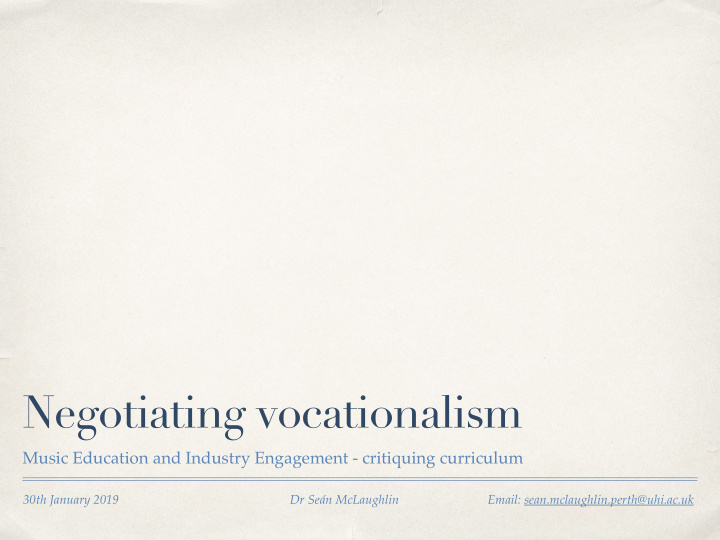



Negotiating vocationalism Music Education and Industry Engagement - critiquing curriculum 30th January 2019 Dr Seán McLaughlin Email: sean.mclaughlin.perth@uhi.ac.uk
Webinar Structure ✤ Music education � ✤ Institutionalisation � ✤ Learning popular music � ✤ Vocationalism � ✤ Discussion
Music Education (a very short history) ✤ Two strands - musicology, and performance practice. � ✤ Musicology - study of composition/composers intentions. � ✤ Performance practice - technical proficiency, repertoire.
Music(s) ✤ Art Music (often described as classical music) � ✤ Folk Music � ✤ Popular Music (see Middleton, 2010)
ART MUSIC TRADITIONS CONSERVATOIRE MOVING INTO FOLK MUSIC TRADITIONS CONSERVATOIRE UNLIKELY TO MOVE DECONSTRUCTS POPULAR MUSIC INTO TRADITIONS CONSERVATOIRE
Institutionalisation ✤ HE conservatoires have an interest in preserving traditions. � ✤ Technical proficiency is key. � ✤ Distinction between musician and audience upheld. (ownership of who can be a musician).
Where does popular music belong? Deconstructs traditions. � - � � Technical proficiency is non-essential.
Learning Popular Music ✤ Began and exists outwith institutions. � ✤ Largely learning and creation takes place informally or non-formally. (see Toynbee, 2000) � ✤ Only really taken seriously as a subject in the 1960s. (*though there are earlier examples such as Theodore Adorno’s 1941 essay On Popular Music)
Vocationalism ✤ Popular music (as a practical subject) began in UK FE colleges in the 1980s and 1990s. � ✤ Roots in business and technical practices. � ✤ There is a historical ideological hangover that sometimes still exists : FE - trade/work/employment.
Employment ✤ Increasing pressure from UK and Scottish government to link education to employment. � ✤ Many have observed a more forceful linkage between educational value and a “neo-liberal meta- policy.” (Giroux, 2014)
Perth College UHI Prospectus The creative sector in Scotland employs around 70,000 people with approximately 14,000 enterprises generating revenue in excess of £3billion. � � Our courses provide a springboard to employment within this creative and diverse sector. � � Within our creative learning environment, you can access outstanding music performance and business programmes – both routes leading to sustainable career opportunities in today’s music industry. � � We aim to give you a comprehensive view of the music industry, from artist development, promoting gigs and music festivals if you follow the music business route and performing in our campus theatre and at local festivals and venues on our music performance courses. � (Perth College UHI, 2018)
Problems with this approach. ✤ 1. Unlike, say, medicine or engineering, our potential students will be musicians whether they study with us or not. � ✤ 2. Our students are musicians regardless of whether or not they are paid. � ✤ 3. The industry is transient - delivering skills/knowledge that suit “today’s music industry” may not be appropriate for tomorrow’s industry, never mind the industry five years from now. � ✤ 4. It assumes that prospective music students are largely motivated by the possibility of employment. � ✤ 5. In scaffolding education around this ideology we construct strange value systems that could impact on how we design assessment.
Ideology and Institutional Values ✤ We know that business/sector (x) need graduates who are capable of ( y). Student ( a) is not interested in ( y) and has no desire to ever work at business (x) . � ✤ Student (a) is less important than business/sector (x). � ✤ Student (a) will only ever achieve surface or strategic learning. � ✤ External relevance is not always inherently positive. � ✤ Easier to centre institutional values on industry needs/potential for financial gain than societal needs. � ✤ Learners stay somewhere near the bottom of Bloom’s taxonomy.
Meaning Construction ✤ What does the term “popular music”? � ✤ Awareness of institutional power in conceptualisation and aesthetic values.
Some questions… ✤ Do we have a responsibility to ensure our graduates are employable? � ✤ Should industry “stake-holders” ever inform curriculum design?
References References � Adorno, T., Leppert, R. and Gillespie, S. (2002). Essays on music. Berkeley, Calif.: University of California Press. � � Bloom, B., Krathwohl, D. and Masia, B. (1984). Taxonomy of educational objectives. New York: Longman. � � Giroux, H. (2014). Neoliberalism's war on higher education. Chicago: Haymarket. � � Green, L. and Fripp, R. (2002). How popular musicians learn: A way ahead for music education (Ashgate Popular & Folk Music S.). Aldershot, UK: Ashgate. � � Middleton, R. (2010). Studying popular music. Milton Keynes: Open Univ. Press. � � Perth.uhi.ac.uk. (2019). Music and Music Business - Perth College UHI. [online] Available at: https://www.perth.uhi.ac.uk/ subject-areas/music-and-music-business/ [Accessed 22 Jan. 2019]. � � Smith, G., Moir, Z., Brennan, M., Rambarran, S. and Kirkman, P. (2017). The Routledge research companion to popular music education. London: Routledge. � � Toynbee, J. (2000). Making popular music. New York: Bloomsbury.
Recommend
More recommend